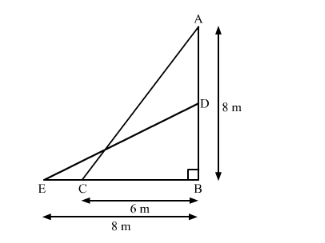The foot of a ladder is 6 m away from a wall and its top reaches a window 8 m above the ground. If the ladder is shifted in such a way that its foot is 8 m away from the wall, to what height does its tip reach?
The given information can be represented as follows.

Here, A is the position of the window and AC is the ladder.
Also, DE is the same ladder when it is shifted.
C and E are the original and final position of the foot of the ladder.
Now, applying Pythagoras theorem in ΔABC,
AC2 = AB2 + BC2
⇒ AC2 = (8 m)2 + (6 m)2 = (10 m)2
⇒ AC = 10 m
Now, again applying Pythagoras theorem in ΔEBD
DE2 = EB2 + BD2
⇒ (10 m)2 = (8 m)2 + BD2
⇒ BD2 = 100 m2 − 64 m2 = 36 m2
⇒ BD = 6 m
Thus, the tip of the ladder is now at the height of 6 m above the ground.
Click here to get exam-ready with eSaral
For making your preparation journey smoother of JEE, NEET and Class 8 to 10, grab our app now.
